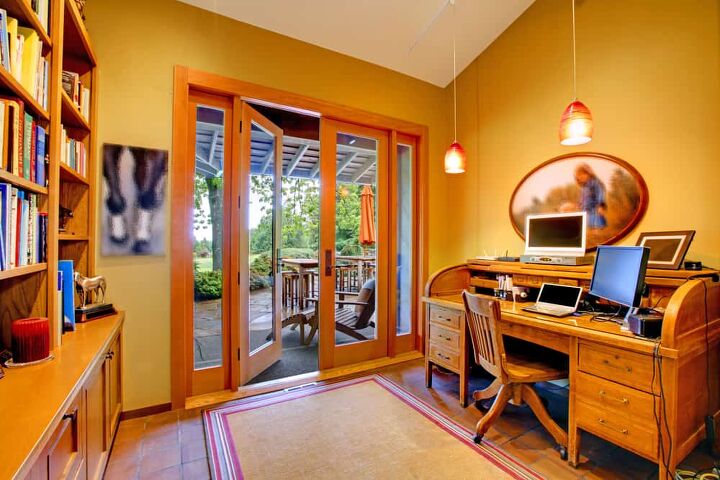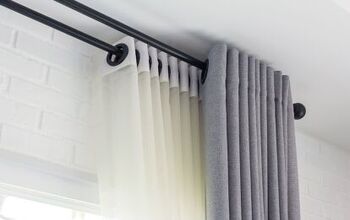How To Remove A Sliding Glass Door (And Install French Doors)

Sliding glass doors were once a staple in homes across the country. But that time was the 1970s and 1980s and those days are long gone. With today’s’ homes, those sliding glass doors can look quite outdated.
Installing French doors provides a modern aesthetic that is popular in just about any style of home. In order to properly remove the old doors, you must remove the frame as well. When all of the components have been removed, dispose of them safely and install the French doors accordingly.
Do You Need a Window and Door Contractor?
Get free, zero-commitment quotes from pro contractors near you.

Why French Doors?
French doors are a great option because they are a versatile choice for backyard entry, porches, and patios. Not only is it aesthetically pleasing, but it is a cost-effective and quick way to update your home and make it feel fresh and new.
French doors are also a great way to provide more natural light into the home, provide an airy feel as well. Most importantly, they are very easy to install, often taking just a few hours to properly install.
Step 1: Take Out the Trim
The first thing that you need to do is remove the trim pieces that comprise the door frame. To do this, you simply need to pry them free using a hammer. It is always best practice to do so carefully. If you simply torque on the trim, they can break and splinter apart.
You also want to be careful in case you want to reuse that trim on your new door. Even if you plan on simply throwing them away, using a little touch to remove the trim is always best because it will make for easy, safe cleanup and disposal.
Step 2: Taking Off the Door
With the trim out of the way, you can now use your nails to take out all of the nails that hold your sliding door where it is. Depending on the way they were installed, there could be several of them in each of the jambs. Check for nails in the head of the frame, too.
Now that all of the nails have been removed, it’s time to take out the sliding door. You should be able to simply pull it free if all the nails are gone. If the sliding door is in pretty good condition, consider donating it to something like a construction salvage facility where it can be eventually reused.
Step 3: Measuring the Opening
The old sliding door should be gone at this point, either off to the side or disposed of entirely. You should be left with an opening that will eventually house your new French doors. We now need to carefully take the measurements to know how big the French doors should be.
When measuring make sure that you are measuring width wise from stud to stud. You will also want to measure from the top of the opening to the finished flooring for your length measurement. It is important that you do this before purchasing your French doors as the measurements could be off and your new doors may not fit properly.
Step 4: Get Your French Doors
The best bet is to go with a set of pre-hung French doors. Use the measurements that you took in the previous step, including the width and length of the frame. The French doors should be around ¼-inch smaller on each of the sides than the measurements of the rough opening.
Another great thing about pre-hung French doors? You should be able to find them at most home improvement stores. The big box stores will offer a pretty good selection, too, giving you options when it comes to your style choice.
Step 5: Installing the French Doors
Now that we have our French doors, it’s time to slide them into the opening. Start with the bottom first and make sure that you center the French doors within the opening. Though it’s entirely up to you, it’s best to make sure that the doors swing outward when installing.
Using your level, ensure that the doors are even and plumb. Depending on the construction, the door jambs, framing, or both could be less than level. When this is the case, use wooden shims between the framing members and the jambs in order to level them out.
Step 6: Securing and Installing Trim
After ensuring that the door is sitting level to the frame, secure them in place. Using three fastening nails into each of the jambs should be enough to properly secure them. If you used shims, make sure to nail them into the frame or jambs accordingly.
Now, it’s time to place insulation to fill in the cracks that exist along the jambs. The best insulation should fill in those spaces without having to be forced to do so and will ensure that your French doors are efficient.
Finally, install the trim kits or the old trim over the frame. The trim will cover the insulation and provide a more pleasant aesthetic, bringing your project to completion.
How Much Does It Cost to Install French Patio Doors?
The cost can vary depending on the brand that you purchase and whether or not you do it yourself. That said, you can expect to spend between $1,000 and $1,5000 on average for French doors. The very low-end models are about $500 while the high-end options skew closer to $4,000. The latter are your custom models.
Another factor is whether or not you go with an oversized model of French doors. The oversize models will require custom doors or additional glass paneling that will close off the opening but won’t swing open themselves.
How Much Does It Cost to Hire a Professional Installer?
Depending on your level of experience and available time, performing the installation yourself may not be something that you want to do. In most situations, you can expect a professional to cost between $400 and $1,400.
What’s included. That amount includes every step of the installation. That includes measuring and preparing the door opening, trimming the door if necessary, setting up a worksite, and performing the installation. Moreover, disposal of debris and waste is generally included in the quoted price.
What’s the process like? To start, most contractors will evaluate the job and provide you with a quote. Depending on the size and conditions of the project, you may be limited in terms of specific door materials and options. Keep in mind that any custom materials will not only cost you more in materials but in labor as well.
Do French Doors Add Value to Your Home?
While it may not seem like it, adding the right door to your home can increase the value of the entire property. This goes for the back of the house openings where French doors are most commonly installed.
The cool thing is that there are calculators out there that can tell you what type of door will add the most value. French doors won’t necessarily increase the value of your home from an aesthetic standpoint, but there are ways that they will help improve the value.
Light. The biggest impact that French doors have is that they infuse more natural light into a space. Natural light can be a great way to make a room brighter and even appear to be bigger. With homes that have a lack of natural lighting, French doors can make for a great addition.
Style. Regardless of your stylistic choices, French doors tend to lend a little bit of elegance and style to a home. If you’re looking to sell your home in the near future, installing French patio doors can be a great stylistic choice.
Access. If there is one thing that French doors are good for, it is providing access. Should you need to move large items in or out of the home, going through French doors will likely always be the best option. Having large access areas can be a major selling point for a home.
Are Sliding Doors or French Doors More Energy Efficient?
Now more than ever, the efficiency of doors and windows is becoming imperative in the home. Old and outdated windows and doors can let make it difficult to regulate temperature, making your HVAC system work overtime. And when that happens, it raises the energy costs in the home.
Despite their visual appeal and ease of access, French doors may not be the most energy-efficient option. As a matter of fact, sliding doors tend to be more energy efficient because they use insulated frames and a glass pack.
The cool thing is that you can find sliding doors in a French style. This way, you get the visual appeal of a French door without the efficiency drawbacks that they offer.
Do You Need a Window and Door Contractor?
Get free, zero-commitment quotes from pro contractors near you.

Are French Doors Easy to Break Into?
One of the primary concerns around French doors is the notion that they are easy to break into. But in reality, French doors are no less secure than any of the other doors on a home. Moreover, there are steps that you can take to make French doors practically burglar-proof.
Related Guides

Ryan Womeldorf has more than a decade of experience writing. He loves to blog about construction, plumbing, and other home topics. Ryan also loves hockey and a lifelong Buffalo sports fan.
More by Ryan Womeldorf



























